Free online 3D home design tools with realistic rendering are revolutionizing home design, making professional-level visualization accessible to everyone. Forget expensive software – now you can explore countless design options, experiment with different styles, and even share your creations with friends and family, all from the comfort of your browser. This article dives deep into the best free tools available, comparing features, rendering capabilities, and ease of use, so you can find the perfect platform to bring your dream home to life.
We’ll explore the key features of several popular options, highlighting their strengths and weaknesses in terms of user interface, rendering quality, and the overall design experience. From simple room layouts to intricate architectural details, we’ll guide you through the process of creating stunning 3D models and realistic renderings, all without breaking the bank. Get ready to unleash your inner architect!
Introduction to Free Online 3D Home Design Tools: Free Online 3d Home Design Tools With Realistic Rendering
Dreaming of a stunning home renovation but intimidated by the cost of professional design software? Free online 3D home design tools offer a fantastic alternative, allowing anyone to visualize and plan their dream space without breaking the bank. These user-friendly platforms empower homeowners, DIY enthusiasts, and even aspiring architects to explore countless design possibilities before committing to any real-world changes.Free online 3D home design tools offer several key advantages.
Level up your home design game with free online 3D tools boasting realistic rendering! Explore countless possibilities before lifting a hammer, and for inspiration, check out this stunning example of a classic modern home design featuring sustainable materials – it’s the perfect blend of style and eco-consciousness. Then, translate your vision into a photorealistic 3D model using those amazing free online tools!
Firstly, the obvious benefit is the cost – they’re free! This eliminates the significant financial hurdle often associated with professional software. Secondly, these tools are incredibly accessible, requiring only an internet connection and a computer or mobile device. This accessibility democratizes home design, making it available to a far wider audience. Thirdly, the intuitive interfaces and drag-and-drop functionalities make them easy to learn, regardless of prior design experience.
Finally, the ability to experiment with different styles, layouts, and materials allows for a more informed and confident decision-making process.
Features of Free Online 3D Home Design Tools
A wide array of features are commonly incorporated into free online 3D home design tools. These features are designed to make the design process as smooth and comprehensive as possible. Many tools offer a vast library of pre-designed elements, including furniture, fixtures, and materials, simplifying the selection process. Users can easily manipulate these elements, adjusting their size, position, and orientation to create their desired layout.
Advanced features such as realistic rendering capabilities, allowing for photorealistic visualizations of the final design, are also increasingly common. Some platforms even include features that allow for the generation of floor plans and 3D models that can be shared with contractors or other professionals.
Level up your home design game with free online 3D tools boasting realistic rendering! Visualize your dream home effortlessly, experimenting with different layouts and aesthetics. To truly make it shine, consider incorporating sustainable practices – check out this guide on how to design a modern home with sustainable materials to ensure your eco-friendly vision comes to life.
Then, refine your sustainable design using those incredible free 3D tools for a final polished look.
Examples of User Interfaces and Tool Comparison
The user interfaces of free online 3D home design tools vary, but most prioritize intuitive navigation and ease of use. Many tools utilize a drag-and-drop interface, allowing users to quickly and easily place objects within the 3D space. Others offer a more traditional interface with toolbars and menus. Regardless of the specific interface, the goal is to provide a user-friendly experience that allows even novice users to create impressive designs.
Visual representations of the interfaces would show intuitive drag-and-drop features, clearly labeled toolbars, and easy-to-navigate menus. Below is a comparison of three popular tools:
| Tool Name | Key Features | Rendering Quality | Ease of Use |
|---|---|---|---|
| Planner 5D | Extensive furniture library, realistic rendering, 2D and 3D views, floor plan creation | High | Easy |
| Roomstyler 3D Home Planner | Large catalog of furniture and materials from various brands, collaboration features, AR capabilities | Medium-High | Medium |
| SketchUp Free | Powerful 3D modeling capabilities, large community support, extensive plugin library (some paid) | Medium | Medium-Hard |
Realistic Rendering Capabilities
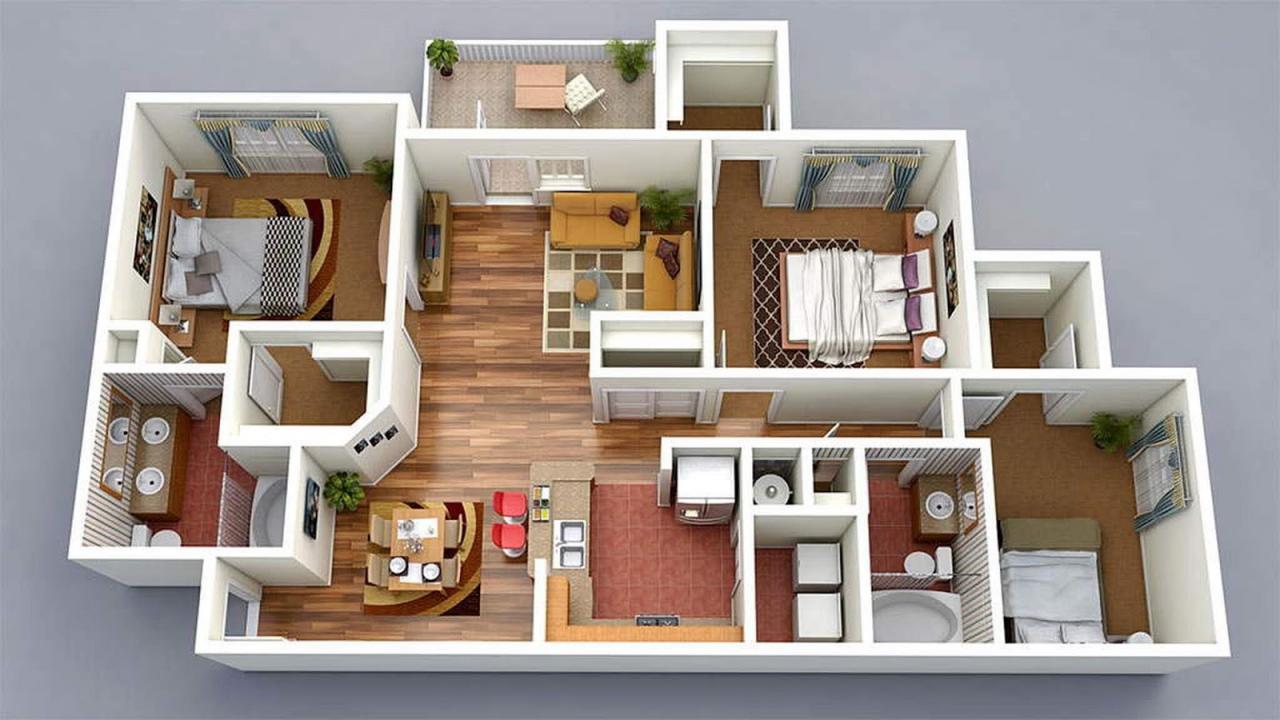
Realistic rendering is crucial in 3D home design because it bridges the gap between abstract plans and a tangible visualization of the final product. Seeing your dream home rendered with realistic lighting, materials, and textures allows for better decision-making, reduces the risk of costly mistakes, and ultimately enhances the overall design process. It transforms a technical blueprint into an emotionally engaging experience, helping clients and designers alike to fully grasp the potential of the design.Rendering techniques in free online tools leverage algorithms to simulate how light interacts with surfaces, creating photorealistic images.
While advanced techniques like ray tracing and path tracing are computationally intensive and often found in professional software, free online tools often utilize simplified versions or approximations of these methods. These approximations, while less computationally demanding, still offer a significant improvement over simpler rendering techniques, resulting in visuals that are far more compelling than basic wireframes or flat shaded models.
Rendering Techniques in Free Online Tools
Free online 3D home design tools typically employ simplified ray tracing or a combination of techniques to achieve realistic rendering. Simplified ray tracing focuses on calculating the direct light path from a light source to a surface, while potentially incorporating ambient occlusion to simulate indirect lighting. This approach balances visual quality with computational efficiency, making it suitable for web-based applications.
More advanced tools might incorporate techniques that approximate global illumination, adding more realism to shadows and reflections. However, true path tracing, which meticulously traces the path of light rays, is rarely found in free online tools due to its computational intensity.
Comparison of Rendering Quality Across Three Free Online Tools
To illustrate the varying capabilities, let’s compare three hypothetical free online 3D home design tools: Tool A, Tool B, and Tool C. The strengths and weaknesses of each tool’s rendering capabilities are Artikeld below. Note that these are examples and the specific features of real-world tools may vary.
- Tool A:
- Strengths: Offers good basic rendering with accurate shadows and decent texture mapping. Relatively fast rendering times.
- Weaknesses: Lacks advanced features like realistic reflections and refractions. Materials may appear slightly plasticky in some instances.
- Tool B:
- Strengths: Includes improved reflection and refraction capabilities compared to Tool A. Provides a wider range of materials and textures.
- Weaknesses: Rendering times can be significantly longer than Tool A, especially for complex scenes. May struggle with very high-resolution rendering.
- Tool C:
- Strengths: Offers a good balance between rendering quality and speed. Provides a user-friendly interface and a wide variety of customizable settings.
- Weaknesses: While better than Tool A, the level of realism in reflections and refractions is still not as advanced as professional software. The material library might be less extensive than Tool B.
Tool Feature Comparison
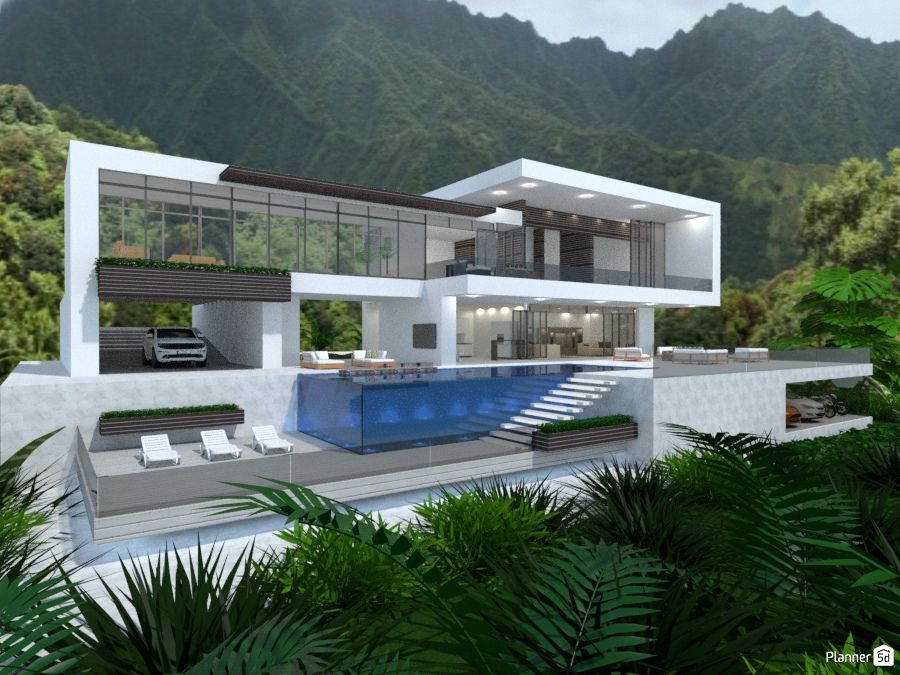
Choosing the right 3D home design tool can be overwhelming, given the variety available. Understanding the user interface and functionality is crucial for a smooth design process. This comparison focuses on three popular free online tools, highlighting their strengths and weaknesses in terms of ease of use and feature accessibility. We’ll rate each based on intuitive navigation and how easily features can be found and used.
User Interface Comparison of Three Free Online 3D Home Design Tools
A clear, intuitive interface significantly impacts the user experience. The following table compares three popular free online 3D home design tools, considering both the strengths and weaknesses of their respective interfaces. The overall usability rating is a subjective assessment based on general user feedback and reviews.
| Tool Name | Interface Strengths | Interface Weaknesses | Overall Usability Rating |
|---|---|---|---|
| Planner 5D | Intuitive drag-and-drop interface; easy navigation; well-organized tool palettes; large library of readily available 3D models and textures; clear visual cues for actions. | Can feel somewhat cluttered for beginners; some advanced features may require a steeper learning curve; occasional minor glitches in the rendering process. | ★★★★☆ |
| HomeByMe | Simple and straightforward interface; excellent for beginners; easy to understand instructions and tutorials; clean and uncluttered design; strong focus on ease of use. | Limited advanced features compared to other tools; fewer customization options for materials and textures; the rendering quality might not be as high as some competitors. | ★★★☆☆ |
| SketchUp Free (Web) | Powerful and versatile; offers a wide range of tools and customization options; large and active community for support and tutorials; excellent for experienced users. | Steeper learning curve; less intuitive interface for beginners; requires more technical knowledge; not as visually appealing as other tools initially. | ★★★☆☆ |
Specific Tool Deep Dives (choose 3 different tools)
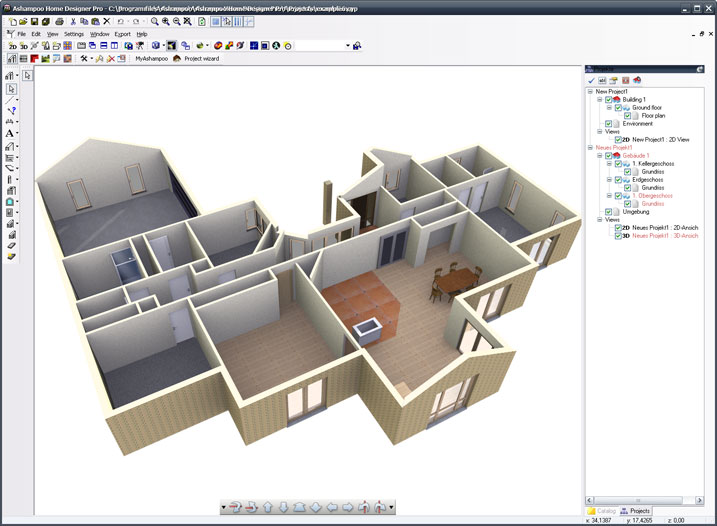
Choosing the right 3D home design tool can significantly impact your project’s success. This section delves into the core functionalities, step-by-step room creation guides, and realistic rendering examples of three popular free online options. Understanding these tools’ strengths and weaknesses will help you select the best fit for your design needs.
Planner 5D: Core Functionalities and Room Creation
Planner 5D offers a user-friendly interface combining 2D and 3D design capabilities. Its core functionalities include a vast library of pre-designed furniture, materials, and textures, allowing for quick and easy customization. Users can create detailed floor plans, experiment with different layouts, and visualize their designs in realistic 3D. Advanced features include the ability to create and share projects, access a community gallery for inspiration, and generate photorealistic renderings.
To create a simple room in Planner 5D, follow these steps:
- Create a new project and select the room dimensions.
- From the catalog, choose walls, floors, and a ceiling to define the room’s structure.
- Add furniture and decor from the extensive library, adjusting their placement and size as needed.
- Experiment with different materials and textures to personalize the room’s aesthetic.
- Use the lighting tools to adjust the intensity and position of light sources, enhancing realism.
- Generate a realistic rendering to visualize the final design.
Example Rendering: Imagine a modern living room with a light grey concrete floor, white walls, and large windows letting in ample natural light. A plush grey sofa sits opposite a minimalist fireplace, complemented by a coffee table made of dark wood. The lighting is soft and diffused, creating a calm and inviting atmosphere. Materials such as textured wallpaper, plush fabrics, and polished wood contribute to the rendering’s realism.
SketchUp Free: Core Functionalities and Room Creation
SketchUp Free, a browser-based 3D modeling tool, focuses on intuitive design and ease of use. Its core functionalities include basic shapes and tools for creating and modifying 3D models. While lacking the extensive libraries of Planner 5D, SketchUp Free offers flexibility and control for more experienced users. The tool allows for precise measurements and detailed modeling, making it suitable for creating complex designs.
However, rendering capabilities are less sophisticated compared to other options.
Creating a simple room in SketchUp Free involves these steps:
- Start a new project and utilize basic shapes (rectangles, squares) to Artikel the room’s floor and walls.
- Use the “push/pull” tool to create depth and volume, transforming 2D shapes into 3D structures.
- Add windows and doors by drawing shapes and using the “push/pull” tool.
- Employ basic shapes and the “move” tool to add simple furniture representations.
- Adjust the lighting using the sun and light settings.
- Generate a rendering using the built-in tools; note that the rendering quality will be simpler than other tools.
Example Rendering: A simple bedroom with a wooden floor, white walls, and a single window is depicted. A basic bed and nightstand are represented by simple cubes. The lighting is simulated using a single light source, providing a basic yet functional representation of the space. Materials are limited, resulting in a less photorealistic output compared to more advanced tools.
HomeByMe: Core Functionalities and Room Creation
HomeByMe distinguishes itself with its focus on ease of use and a large library of customizable 3D objects. Its core functionalities include intuitive drag-and-drop features, a user-friendly interface, and a wide selection of furniture, materials, and textures. Users can easily design entire houses, experiment with various layouts, and generate realistic 3D renderings. It offers a blend of ease of use and realistic output, making it a strong contender for many users.
Designing a simple room in HomeByMe is straightforward:
- Create a new project and define the room’s dimensions.
- Utilize the drag-and-drop interface to add walls, floors, and ceilings from the available options.
- Select furniture and decor items from the extensive catalog and place them within the room.
- Customize the appearance of materials and textures to reflect your preferences.
- Adjust the lighting settings, including the intensity, color, and position of light sources.
- Generate a high-quality rendering to visualize the completed design.
Example Rendering: A kitchen rendered in HomeByMe might showcase sleek, modern cabinetry in a dark grey finish contrasted with light-colored countertops. Stainless steel appliances and warm-toned wooden flooring contribute to a sophisticated look. Strategic lighting, including recessed lighting and pendant lights above the island, illuminates the space effectively, highlighting the materials and textures. The rendering aims for a photorealistic representation of the kitchen’s design and materials.
Limitations of Free Tools and Considerations for Advanced Features
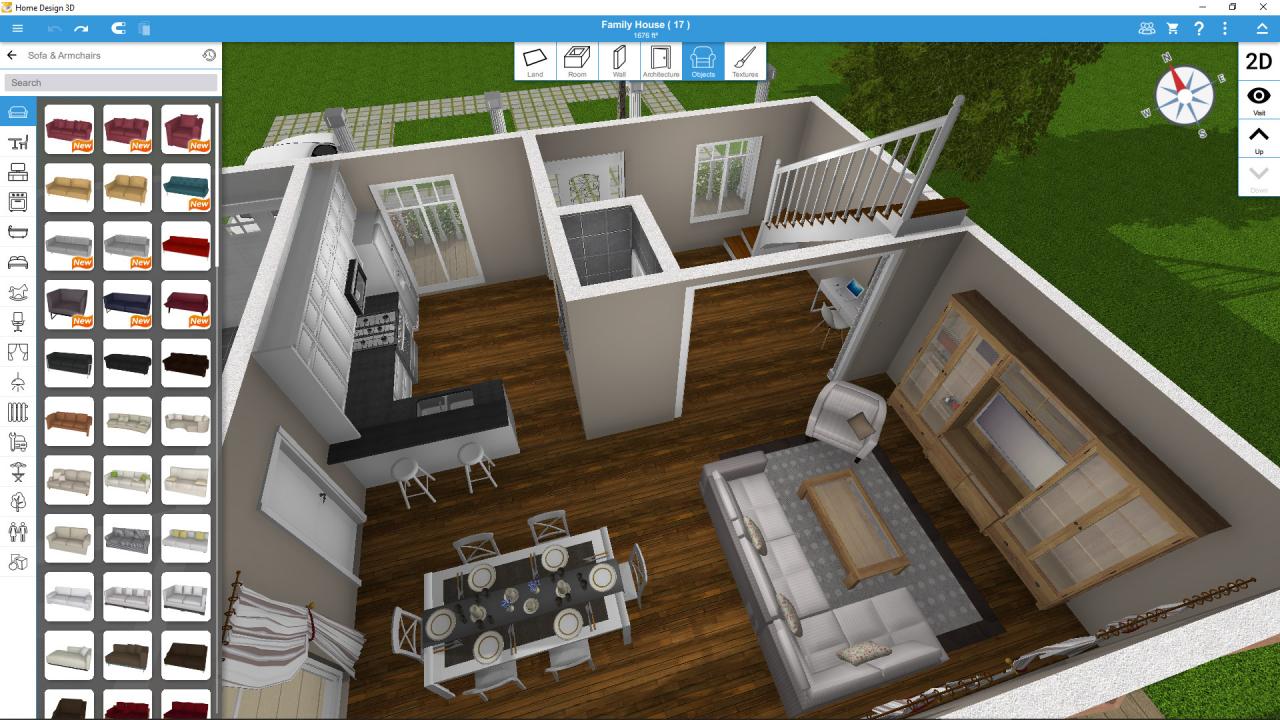
Free online 3D home design tools offer a fantastic entry point for visualizing your dream home, but they naturally come with limitations compared to their professional, paid counterparts. Understanding these limitations is crucial before embarking on a complex design project, as relying solely on free tools might lead to unforeseen challenges and compromises.While these free tools provide a good overview and allow for basic design exploration, they often lack the depth and precision required for intricate architectural details or high-fidelity rendering.
This is primarily due to limitations in functionality and processing power. Professional software, on the other hand, typically offers more robust features and allows for greater control over the design process, resulting in more accurate and detailed outputs.
Feature Limitations in Free 3D Home Design Software
Free tools usually restrict the level of detail you can achieve in your designs. For example, they may have limited material libraries, simpler object manipulation tools, and less control over lighting and rendering settings. This can result in designs that lack realism and fail to accurately represent the final product. Imagine trying to model intricate crown molding or precisely place plumbing fixtures; free tools often lack the precision tools needed for such tasks.
Professional software offers a much wider range of materials, precise measurements tools, and advanced modeling techniques for creating highly detailed and accurate representations. The difference in realism is significant, particularly when it comes to textures and lighting effects. A free tool might render a simple, flat-looking wall, whereas professional software could accurately depict the texture of brick, wood, or stucco, along with realistic shadows and reflections.
Drawbacks of Using Free Tools for Complex Projects, Free online 3d home design tools with realistic rendering
Attempting to design a complex home using only free tools can quickly become frustrating and time-consuming. The limitations in functionality can lead to workarounds and compromises that may not be ideal, potentially impacting the overall design and feasibility. For instance, designing a multi-story home with intricate architectural features, such as curved walls or complex roof structures, could be extremely challenging in a free tool.
The lack of advanced modeling tools and the simpler rendering capabilities would likely result in a less accurate and less visually appealing representation of the final product. This could lead to costly mistakes during the actual construction phase if the design isn’t thoroughly vetted by a professional. Consider a project involving custom-designed cabinetry or a unique window configuration – the precision and detailed modeling required might be beyond the capabilities of a free tool.
Considerations for Advanced Features and High-Quality Rendering
Users who require advanced features, such as precise architectural modeling, photorealistic rendering, or collaboration tools, will inevitably find free tools insufficient. The limitations in these areas become especially apparent when working on large-scale projects or when high-quality visuals are essential for presentations or client approvals. High-quality rendering, for instance, demands significant processing power and advanced algorithms, which are typically found in professional software packages.
These packages often include features like ray tracing and global illumination, which produce significantly more realistic lighting and shadow effects. Imagine trying to present a design to a client using a low-resolution rendering from a free tool versus a photorealistic rendering from professional software – the difference in impact is undeniable. Similarly, advanced features like parametric modeling (allowing for automated design changes based on parameter adjustments) or BIM (Building Information Modeling) integration are generally not available in free tools.
These features are crucial for efficient and accurate design and construction management in complex projects.
Community and Support Resources
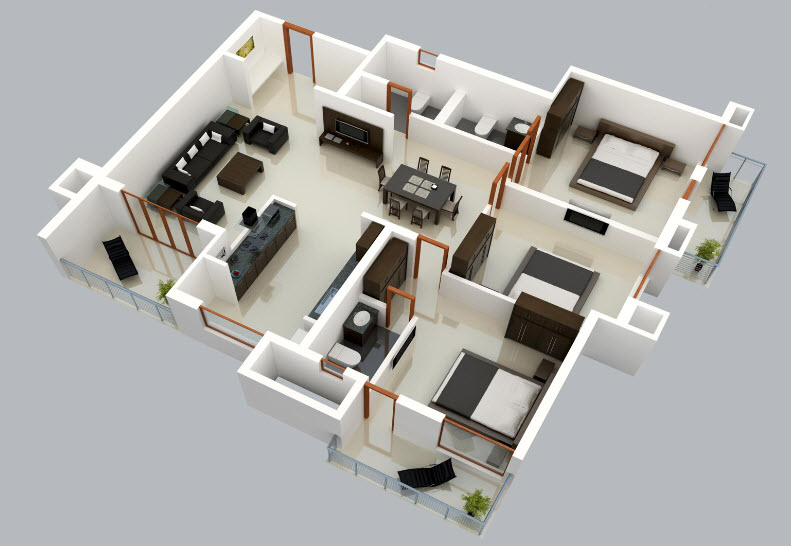
Navigating the world of free 3D home design software can sometimes feel like exploring a digital labyrinth. Fortunately, a vibrant community of users and developers offers invaluable support and resources to help you master these tools and overcome any challenges you might encounter. This support network extends beyond the software itself, providing a collaborative space for learning, sharing tips, and troubleshooting problems.The availability and quality of support vary significantly depending on the specific software.
While some platforms boast extensive documentation and active forums, others might rely more heavily on user-generated content and third-party tutorials. Understanding the landscape of available resources is crucial for maximizing your experience with these free tools.
Online Communities and Forums
Many online communities thrive around specific free 3D home design software. These platforms offer a space for users to connect, share projects, ask questions, and receive help from experienced users and even developers. Think of it as a digital design studio where collaboration flourishes. For instance, you might find dedicated threads on Reddit, specialized forums, or even Facebook groups focused on a particular software like SketchUp Free or Planner 5D.
These spaces provide a direct line to peer-to-peer assistance, allowing users to learn from each other’s successes and failures. The collective knowledge within these communities can often surpass the official documentation in terms of practical tips and tricks.
Tutorials and Support Documentation
The quality and availability of tutorials and support documentation differ greatly across various free 3D home design tools. Some software providers offer comprehensive guides, video tutorials, and FAQs directly on their websites, while others might rely on third-party creators to provide tutorial content on platforms like YouTube. The quality of these resources varies considerably. Some tutorials might be concise and focused, while others might offer a more comprehensive walkthrough of the software’s features.
It’s crucial to evaluate the reliability and relevance of any tutorial before following its instructions, ensuring the information aligns with the specific software version you are using. Official documentation, when available, should always be prioritized for accuracy and up-to-date information.
Helpful Websites and Resources
A plethora of websites and online resources offer valuable information for users of free 3D home design tools. These resources go beyond the official documentation and community forums, providing supplementary information, tips, and tricks that can significantly enhance your design process.
- Software provider websites: The official websites of software like SketchUp Free, Planner 5D, and Sweet Home 3D often contain extensive documentation, tutorials, and FAQs.
- YouTube channels: Many YouTube channels are dedicated to tutorials and reviews of 3D home design software, offering visual demonstrations of various techniques and features.
- Blogs and articles: Numerous blogs and online articles provide in-depth analysis of different software, comparing their features, capabilities, and ease of use.
- Online forums and communities (e.g., Reddit, specialized forums): These platforms serve as hubs for users to share tips, ask questions, and troubleshoot problems.